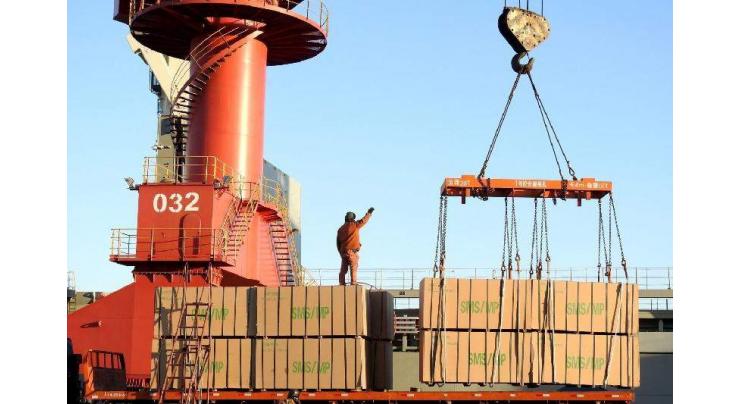
Growth Holding Up In Asia And The Pacific, Trade Tensions Pose Risks
Umer Jamshaid Published September 26, 2018 | 04:56 PM

Growth remains stable across most of developing Asia due to robust domestic demand, buoyant oil and gas prices but escalating trade tensions will test the region's resilience, underscoring the importance of efforts to bolster trade ties among its countries, says a new Asian Development Bank (ADB) report.
ISLAMABAD, (UrduPoint / Pakistan Point News - 26th Sep, 2018 ) :Growth remains stable across most of developing Asia due to robust domestic demand, buoyant oil and gas prices but escalating trade tensions will test the region's resilience, underscoring the importance of efforts to bolster trade ties among its countries, says a new Asian Development Bank (ADB) report.
In an update of its flagship annual economic publication, Asian Development Outlook (ADO) 2018, ADB maintains its forecast that the region's gross domestic product (GDP) will grow at 6.0% in 2018. The growth forecast for 2019 is trimmed by 0.1 percentage points to 5.8%.
"Growth in the region has held up to external challenges, helped by strong domestic demand in the People's Republic of China (PRC) and India," said ADB Chief Economist Mr. Yasuyuki Sawada. "The biggest risk to continued growth comes from the disruption of international production linkages caused by a further escalation of trade tensions, but Asia's growth should remain resilient to the direct effects of the trade measures taken to date." Strong domestic demand is driving the region's largest economies, while buoyant prices for oil and gas are fueling growth at energy-exporting countries like Kazakhstan.
However, emerging headwinds cast uncertainty on the region's future growth trajectory.
In addition to escalating trade tensions, tightening global liquidity could further cloud prospects over the coming year.
Industrial economies' growth will reach 2.3% in 2018 and 2.0% in 2019, maintaining the April 2018 forecast. Consumer spending and job creation is driving strong growth in the United States.
However, recovery in the euro area and Japan was sluggish early in the year, prompting slight downward revisions to their 2018 growth projections.
The US is expected to normalize monetary conditions further to preempt inflation.
Solid domestic consumption and rapid expansion of services helped to deliver strong economic performance in the PRC over the first half of the year.
The growth outlook for 2018 remains unchanged at 6.6% but is revised down to 6.3% for 2019, reflecting lower demand growth and the risk of escalating trade tensions.
Supply-side reform supported by monetary and fiscal measures will help to keep growth on track, the report notes.
India's economy continues on a robust growth path. Its growth forecasts are unchanged at 7.3% for 2018 and 7.6% for 2019 as the temporary effects of the demonetization of large banknotes and the introduction of the national goods and services tax abate as expected.
The impact of rising oil prices is offset by robust domestic demand and rising exports, particularly of manufactures.
Depreciation of the rupee and volatile external financial markets pose challenges, as does accelerating inflation though tighter fiscal policy will help quell inflationary pressures.
Growth is moderating in 6 of the 10 countries of Southeast Asia, which is now expected to grow by 5.1% in 2018, a drop of 0.1 percentage points from the previous forecast. Net exports moderated growth in Indonesia, the Philippines, Thailand, and Viet Nam as imports surged to support government infrastructure investments. Growth should register 5.2% in 2019, consistent with the April 2018 forecast, though downside risks have intensified.
Higher prices for oil and natural gas, coupled with rising exports and investment are driving slightly higher growth in Central Asia, which is expected to hit 4.1% this year. Conversely, the Pacific is expected to expand by just 1.1%, half the previous forecast, due to disruptions from an earthquake in Papua New Guinea and public spending shortfalls in Timor-Leste.
Risks to the region include financial shocks if the US Federal Reserve needs to raise interest rates faster than currently expected to stave off inflation. But the biggest risk is the impact of worsening trade conflict on cross-border production networks as business ties are severed and investment plans cancelled.
While some economies, particularly in Southeast Asia, could gain over the medium term as trade is redirected to them, indirect fallout could lower confidence and investment throughout the region. As such, ongoing efforts by Asian countries to forge trade agreements within the region and beyond provide an important counterpoint to rising protectionism.
Related Topics
Recent Stories

Hania enjoys vacations in London

IMF Officials assure support to Pakistan’s economy

Naqvi directs foolproof measures for protection of Chinese nationals

Israel carries out attack inside Iran, report US media

Saudi Assistant Minister of Defence calls on army chief

Currency Rate In Pakistan - Dollar, Euro, Pound, Riyal Rates On 19 April 2024

Today Gold Rate in Pakistan 19 April 2024

Rock-solid Ruud racks up season-leading win in Barcelona

At UN, Iran says it will make Israel 'regret' reprisals

G7 hears calls for 'critical' Ukraine aid

EU seeks to leverage might to confront China, US challenge

5 Customs officials martyred as their vehicle ambushed by terrorists in D I Khan
More Stories From Business
-
Tokyo's Nikkei index tumbles 3% in morning trade
19 minutes ago -
Weekly inflation falls by 0.79 percent
30 minutes ago -

IMF Officials assure support to Pakistan’s economy
52 minutes ago -
Gold rates up by Rs 500 to Rs 250,700 per tola
1 hour ago -
Japanese auto giant Nissan cuts sales, profit forecasts
2 hours ago -
KPT shipping movements report
3 hours ago
-
Food exports grew by 48.17% in 09 months, reached $5.651 bln
4 hours ago -
Exchange rates for currency notes
6 hours ago -

Currency Rate In Pakistan - Dollar, Euro, Pound, Riyal Rates On 19 April 2024
7 hours ago -
Foreign exchange rates
7 hours ago -

Today Gold Rate in Pakistan 19 April 2024
8 hours ago -
Oil jumps more than 3% on Middle East worries
8 hours ago








